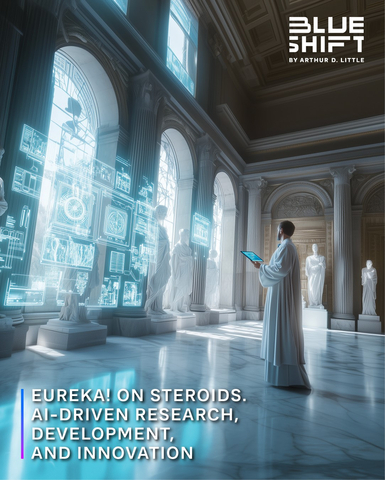AI has started to power all steps of research, development, and innovation (R&D&I), including those that require creativity, working alongside and augmenting humans, with its use increasing rapidly. However, while it is already delivering major productivity gains in specific areas or sectors its widespread integration into R&D&I processes is still relatively immature, and it faces a range of challenges around technology, economics, regulation, and societal acceptability. Irrespective of these challenges, six no-regret strategic actions should be undertaken today. These are the headline findings of Eureka! on Steroids: AI-driven research, development, and innovation, a new report published today by Arthur D. Little (ADL)’s Blue Shift Institute.
This press release features multimedia. View the full release here: https://www.businesswire.com/news/home/20250115868503/en/

In this new study, Arthur D. Little explores the current state of AI in research, development, and innovation. (Photo: Business Wire)
The report was conducted in partnership with five major leading public and private sector organizations already using AI in their R&D&I efforts: LVMH, Avril, GRTgaz, the French National Centre for Scientific Research (CNRS), and the French National Research Institute for Agriculture, Food, and the Environment (INRAE).
While AI has played a part in R&D&I for at least a decade, recent advances have turbocharged AI use, opening up transformative new possibilities and promising more compelling eureka moments, more often.
The in-depth study therefore explores the benefits that AI is already delivering in terms of greater productivity, faster development and the ability to solve previously intractable problems in R&D&I, as well as challenges and best practices, the landscape of solution providers, and future scenarios. It is based on over 40+ interviews with AI experts from the academic, startup, and corporate worlds. It also leverages a survey of over 200 experts from private companies and public institutions, as well as a column by Anne Bouverot, a world-renowned expert and the French President’s Special Envoy on AI.
Key factors impacting the future adoption of AI in R&D&I are performance, trust and affordability. Based on the combination of these elements, the report outlines six plausible scenarios that impact the direction of AI, ranging from it being solely used in selected, low-risk scenarios to a full transformation of R&D&I.
Whatever scenario materializes, organizations need to act now to prepare. Ensuring success requires organizations to manage and empower AI talent, build robust data foundations, train the workforce in AI fundamentals, prioritize use cases that deliver tangible, rapid benefits, mutualize computer power, and put in place strong governance frameworks to ensure quality and control.
Dr. Albert Meige, Global Director of Blue Shift at Arthur D. Little, comments: “Research, development, and innovation (R&D&I) is at the heart of solving the main challenges that the world faces in areas as diverse as sustainability, health, climate change, and food and energy security. Our study shows that not only does AI have the power to transform R&D&I, helping to meet these needs, but that many organizations are already reaping its benefits across all stages of their operations. While challenges remain and the level of AI use will depend on its performance and trust, we identify the ‘no regret’ moves that organizations should make now to prepare for the future.”
Eureka! on Steroids: AI-driven research, development, and innovation, can be viewed and downloaded here: https://tinyurl.com/yf4pt6r5
For further information, please visit www.adlittle.com
View source version on businesswire.com: https://www.businesswire.com/news/home/20250115868503/en/
Sue Glanville
Catalyst Comms
+44 7715 817589
[email protected]
© Business Wire, Inc.
Haftungsausschluss :
Diese Pressemitteilung ist kein von AFP erstelltes Dokument. AFP übernimmt keine Verantwortung für ihren Inhalt. Bei Fragen wenden Sie sich bitte an die im Text der Pressemitteilung genannten Kontaktpersonen/Stellen.
